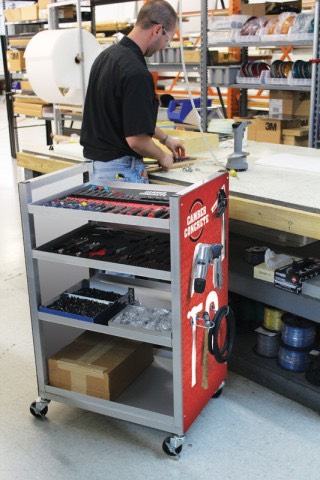
WASTE: What you can do to eliminate it
Waste is an awful word that devalues quality, manufacturing processes, and your business’ bottom line. Perhaps you have already put a lot of effort into lean manufacturing principles – striving to eliminate waste. Let’s dive into the 5S principles and learn to avoid the 8 wastes.
Conflict is at the root of all waste.
As the VP of the AME Northeast Region, I get to meet Thought Leaders locally and from around the county. I was a guest at a fantastic workshop led my Scott Gauvin from Macresco, Conflict is the Root of All Waste.
Gauvin stated that “for every $10,000 spent on labor, $3500 of it is waste due to unresolved conflict.”
He asked the group, “Do people dislike and fear change”?
Of course, everyone responded, “Yes!”
Gauvin claims that this is not the case at all. Rather, human beings are petrified of the unknown, not change. We are less interested in “What’s in it for me?” but more worried about “What’s at risk for me?”
For example, let’s say you’re writing something on a white piece of paper. Someone comes up to you and says “Hey, can I change that from white to yellow paper?” You would likely acquiesce no problem. Yet the old wisdom would suggest that since you experienced a change that you would have disliked it. In reality, there was no risk in changing the color of your paper, so naturally, you have no issue with it. VERY important distinction!
Get your employees involved.
Start by involving your greatest assets—your employees. Management is always looking for ways to change their company’s work culture for the better. When your workers feel safe, they feel valued, have better attitudes, and are more likely to welcome change.
If you start a positive culture in your workplace, your employees will be more open to change – including serious organization! By creating a positive culture you will improve communication and make your workers feel empowered to make decisions.
Sometimes breaking bad habits is challenging but if you promote 5S to eliminate waste by creating a positive culture in your workplace, it will happen. Hear the disembodied voice echo, “If you build it, they will come.”
Waste is a stumbling block on the path to success.
Google defines success like this:
“The accomplishment of an aim or purpose; the attainment of popularity or profit; a person or thing that achieves desired aims or attains prosperity.”
Have you ever thought about success as a series of steps you have to take to get from point A to point B?
How do you reach your desired level of success and stay there? Every business is different but I’m sure most have “organization” near the top of the list! Eliminating anything that doesn’t add value to your company is a good starting point for creating a lean, organized workplace. Eliminating the eight deadly wastes is a great place to start.
The 8 Deadly Wastes, and what to do about them

1. Defects
Defects are a direct result of both human error and improper machinery. Defective products can’t be sold to consumers and require the product to be scrapped or reworked. Tips to eliminate issues with defects:
- Apply automation: the technique, method, or system of operating or controlling a process by using mechanical devices.
- Perform a problem-solving solution called a root cause analysis. The most common analysis asks “why” five times until the true source underlying a problem is discovered.
2. Overproduction
Overproduction is the production of goods in greater quantities than needed, i.e. making products before they’re needed or making more product than required to fill an order. It will create excess inventory, which takes up space. Tips to eliminate overproduction:
- Build to takt time – the maximum amount of time a product needs to be produced in order to satisfy customer demand.
- Create a Kanban pull system to regulate the flow of goods inside the plant and between suppliers. A pull system will free up space in the workplace and reduce the cost of storing excess inventory.
3. Waiting
Waiting is when work-in-process stops until the next step can be completed and prevents the completion of a product. Often times, a product is waiting for raw material or component parts before it can move through the process of completion. Tips to eliminate waiting:
- Maintain a smooth process of continuous flow in your production.
- Identify and eliminate ‘waiting’ barriers.
- Create standardized work procedures that describe the best practices for completing each task and update the processes as required.
4. Transportation
Transportation is the unnecessary movement of raw materials through manufacturing processes. Tips to eliminate transportation issues:
- Create centralized manufacturing operations per plant so that each plant manufacturers specific products on it’s own.
- Establish a flow of production that only places finished goods into inventory.
5. Inventory
Inventory is any products that go beyond supporting the immediate need. Is stock depleted, overflowing, or outdated? Tips to eliminate inventory issues:
- Avoid untimely depletion of stock by monitoring inventory for low stock numbers.
- Bring in raw materials only as they are needed and practice Just-In-Time (JIT). JIT is the process of pulling parts through production based on customer demand rather than pushing parts through production based on projected demand.
6. Motion

Motion is the unnecessary movement of people that don’t add value. For example, a worker must walk away from his/her work station to grab something across the plant in order to effectively complete their job. Tips to eliminate issues with motion:
- Improve the production line and provide all stations with the resources they need to complete specific tasks.
- Re-arrange equipment and processes to reduce the amount of wasted motion.
- Create clean, organized, and logical workspaces that are efficient.
7. Extra Processing
Extra processing is overproducing orders and often one of the most difficult wastes to detect and eliminate. Tips to eliminate extra processing:
- Proactively create a strategy where all employees at all levels of your company work together towards the common goal to improve the manufacturing process.
- Compare customer requirements at quality control checkpoints and report any excess so you can change/simplify the manufacturing process.
8. Non-Utilized People
Once you re-evaluate the process of lean manufacturing and implement proper solutions to problems, some of the tedious jobs may become obsolete. Tips to improve jobs for non-utilized people:
- Develop strong coaching skills for management so they know where to place employees to effectively contribute to your business.
Organization is key to eliminate waste and increase productivity
Along with establishing a sense of structure and order, an organized work environment helps us see the bigger picture without sifting through the noise and the clutter. When unnecessary clutter (all clutter is unnecessary, actually) accumulates our attention becomes divided and we cannot perform at 100 percent. Eliminate the waste of clutter!
Project managers often quote the Italian economist Pareto’s Principle – The 80/20 Rule. The 80/20 Rule states that 20% of the inputs or activities are responsible for 80% of the outcomes or results. This rule is useful for analyzing efforts in the workplace. Do you spend 80% of the time finding the tools you need to finish 20% of the work?
Most Effective Ways to Get Organized
Keep everything you need within arm’s reach.
Take a thorough inventory of everything you use on a regular basis to complete your work and keep these items in your workspace. Any tool or equipment that is used once a week should be kept within the work area. Anything that’s used less frequently should be stored in a distant location.
Utilize visual displays.
Visual displays that keep your tools and equipment together provide an ideal way to keep everything organized and readily available when you need them. When you can quickly find the tools you need, when you need them, you will maximize productivity, encourage employee engagement and make organization easier for all.
Eliminate waste and non-essentials.
Clutter is a distraction and can cause health issues, too. Some studies say clutter has a negative effect on your emotions, mental level, and physical health. When you get rid of clutter, your workspace is more functional and you can focus more on your tasks.
Check out a few tool control products we recommend that will help you reach your goal of a successfully organized workspace:
- Foam Tool Organizers: Keep tools organized and accounted for at all times. With Foam Tool Organizers you can eliminate FOD (foreign object damage) and ensure the tools you need are always placed into their exact cut-out location after every use.
- Tool Shadow Boards: With Tool Shadow Boards you can visually see all the items you use on a regular basis in a neat and organized way. When you can easily identify the location of your tools, you can quickly see if a tool is being used, which will significantly cut down on downtime searching for misplaced tools.
- Cleaning Station Tool Shadow Board: With Cleaning Station Tool Shadow Boards you can color-coordinate the tools and boards that are used throughout your facility for general maintenance organization. For example, you wouldn’t want to use the same tools on the production floor and front office. Keep the tools separate with color-coded cleaning stations.

